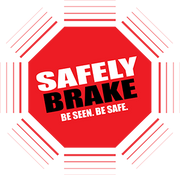Be Seen. Be Safe.
Be Safe
Rear-end crashes account for more than 29 percent of all crashes; these types of crashes often result from a failure to respond (or delays in responding) to a stopped or decelerating lead vehicle.
(NHTSA www.nhtsa.gov)
Show Me More
The Study
Testing was performed with a group of 80 naïve participants under static conditions; individuals did actually not drive the vehicle. Signal eye-drawing capability was assessed using a series of uninformed lighting event detection trials in which participants were exposed to candidate brake signals while engaged in a secondary task. These trials were administered before participants were informed about the true purpose of the study. The uninformed event trials were intended to supplement subjective ratings with performance-based values (i.e., incidence of glances to the forward view when otherwise occupied). During the uninformed trials, participants were asked to complete in-vehicle tasks using an in-car navigation system; this task was designed to direct their gazes away from the forward road-way and the brake lighting mock-up (refer to the picture). The mock-up was outfitted with the candidate brake signals and was positioned 100ft straight ahead of the subject vehicle.
Brake lights on the mock-up were activated when the participant was glancing toward the navigation system display. These triggering events occurred three times as follows: once while receiving instruction but looking at the navigation system display, once when selecting among menu items in the navigation system, and once during text entry at the navigation system. These three events were chosen to reflect increasing levels of visual, cognitive, and manual loading. The number of occurrences of eye-drawing (participants looking-up) and the times it took them to re-direct their gaze forward were measured and served as key dependent measures for assessing eye-drawing capability. Ratings of attention and glare were also captured for all of the candidate rear signal lighting configurations. percent-of-drivers.
In all, the study examined the following nine brake light signal configurations (all except the first used LED units):
- Traffic Clearing Lamp (Incandescent) combined with out-board lamps at increased steady brightness
- Simultaneous Flashing of All Lamps With Increased Brightness, optimized in frequency according to previous experiments under the current project
- Simultaneous Flashing of All Lamps With No Increase in Brightness, optimized in frequency according to previous experiments under the current contract
- Increased Lamp Intensity Enlarged Brake Lamp Area and Increased Brightness
- Outboard Alternating Flashing, Center, High-Mounted Signal Light (CHMSL) Steady (Alternating Pair, Outboard), optimized in frequency according to previous experiments under the current project
- Outboard Simultaneously Flashing, CHMSL Alternately Flashing, optimized in frequency according to previous experiments under the current project Two CHMSL Lamps Alternately Flashing, Out-board Steady (Alternating Pair, CHMSL), optimized in frequency according to previous experiments under the current contract
- Baseline (Conventional, Steady Burn) A subset of five configurations was evaluated using the uninformed event detection paradigm (shown in bold).
These configurations correspond to the bolded conditions presented in the above list. Eighty drivers participated in the uninformed event detection paradigm; 16 drivers in each of the five display conditions. Results generally support Configuration 2 (simultaneous flashing and increased brightness) as most effective in drawing the participants eyes back to the forward view. In all, 69 percent of participants noticed the lighting on at least one occasion when simultaneous flashing and increased brightness were combined. This compares to 0 percent for the baseline configuration, suggesting that current rear lighting is much less effective in drawing the participants eyes back to the forward view.
These results are for the case in which bright daylight floods the lead vehicle and the participant is involved in an in-car task requiring visual and cognitive load, a task that could be considered typical of more complex in-car tasks. Flashing alone (without increased brightness) demonstrated a modest improvement in eye drawing; however, this configuration is far less effective than flashing with increased brightness insofar as the testing performed in the current study is concerned.
In terms of rated attention-getting, whether looking straight ahead at a distance of 100 ft (30.5 m) or looking to the right at an angle of 30 deg., drivers rated Configurations 2 (Simultaneous Flashing of All Lamps With Increased Brightness), 6 (Outboard Alternating Flashing, CHMSL Steady), and 7 (Out-board Simultaneously Flashing, CHMSL Alternately Flashing) as the most attention-getting. All three configurations used increased brightness. Clearly, flashing and increased brightness play a major role in attaining high ratings by the research participants. These results suggest that both flashing and brightness are effective in increasing the attention-getting ratings. Note in particular that flashing alone (center bar in the bar graph to the right) causes a reduction in rating values that is more than 1.5 rating points lower that the average of the top three configurations, all of which make use of the higher (emergency) lighting level. This result is similar to those shown for the uninformed event detection portion of the experiment (eye-drawing) in that increased brightness improves the percentage of participants who looked up at the lighting display.
Both look-up (eye drawing) data and interview data support the hypothesis that simultaneous flashing of all rear lighting combined with increased brightness would be effective in redirecting the driver’s eyes to the lead vehicle when the driver is looking away with tasks that involve visual load. This Vehicle Safety Research Note is a summary of the technical research report: Evaluation of Enhanced Brake Lights Using Surrogate Safety Metrics. Task 1 Report: Further Characterization and Development of Rear Brake Light Signals. Report No. DOT HS 811 127. Washington, DC: National Highway Traffic Safety Administration. This report can be downloaded free of cost on the Vehicle Safety Research section of NHTSA’s Web site (www.nhtsa.gov).

